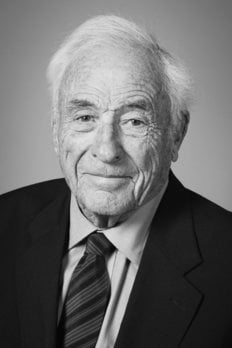Willard S. Boyle
Biographical

I was born on August 19, 1924 in Amherst, Nova Scotia and raised in the village of Wallace until I was about two years old. At this time, my family moved to Chaudiere, a small logging community in northern Quebec. My father was the local physician in the community and my mother took on the task of home schooling me. She believed in the Socratic method of teaching, asking me questions about my work for the day that required very detailed explanations as answers. She was a curious woman, and through her teaching I developed a strong curiosity as well. When I was fourteen, I began my formal education at Lower Canada College in Montreal. My peers were a stark contrast to the logging men I’d known growing up and I quickly earned the nickname Butch.
Following Lower Canada College, I continued to pursue my scientific interests at McGill University. Then, in 1943, I had some time away from my studies, when I joined the Royal Canadian Navy. From there I applied to the Fleet Air Arm and was trained to land Spitfire fighter planes on aircraft carriers. When the war was coming to an end, I was anxious to return home to school. The transition back to class was not easy, but I found it very helpful that my best friend from the Navy was also at McGill and we were able to work together to adapt back to our old lives. During this same fall I met my wife Betty, who made me believe in love at first sight. We married in 1946 and had our first son, and in 1947 we had our first daughter and I completed my Bachelor of Science. With two young children at home only twenty-one months apart, I continued my studies at McGill, completing my Masters in Science in 1948 and Doctorate in Physics in 1950.
After completing my Doctorate, I remained at McGill in Canada’s Radiation Laboratory for one year. I then spent two years teaching physics at the Royal Military College of Canada in Kingston, Ontario. Here Betty and I purchased our first small house for our growing family while welcoming our next son in 1952. About this time, I was met with several new opportunities for employment. In 1953, after careful consideration, I decided the academic community available through Bell Labs would become my new home. While work life became very busy, in 1955 we welcomed our youngest daughter into the world.
My time with Bell Labs was always challenging, and this led to several important discoveries. In 1962, I worked with Don Nelson to create the first continuously operating ruby laser. Also in 1962, I became the Director of Space Science and Exploratory Studies at Bellcomm, a division of Bell Labs in Washington, D.C. While at Bellcomm I supported the Apollo space program and was able to aid in the selection of lunar landing sites. I returned to Bell Labs in 1964. Then in 1969, during a brainstorming session with George Smith, we created the charged-coupled device. During my time at Bell Labs I worked on about 18 patents.
I retired from Bell Labs in 1979 as the Executive Director of the Communication Science division. Retired at 55, I sailed my 33-foot boat for six leisurely weeks up the inland waterway from New Jersey, the New York Harbor and up to Quebec and down the St. Lawrence to the house we had built in Wallace. I was accompanied by five or six different crews made up of former assistants, friends and family, and a cat and a dog. Following this I have continued to live in Wallace, Nova Scotia and Lac Tremblant, Quebec. I have been graced with ten wonderful grandchildren and one great-grandchild.
I have been active in several advisory capacities and have won several awards (listed below) for my work.
| • The Ballantine Medal of the Franklin Institute, 1973. |
| • Morris Lieberman Award of the IEEE, 1974. |
| • Progress Medal of the Photographic Society of America. |
| • Breakthrough Award by the Device Research Conference of the IEEE. |
| • Co-winner, C&C prize of the NEC Foundation, Tokyo, 1999. |
| • Edwin H. Land Medal, Optical Society of America, 2001 |
| • Canadian Science & Engineering Hall of Fame, 2005. |
| • Charles Stark Draper Prize, National Academy of Engineering, 2006. |
This autobiography/biography was written at the time of the award and later published in the book series Les Prix Nobel/ Nobel Lectures/The Nobel Prizes. The information is sometimes updated with an addendum submitted by the Laureate.
Willard S. Boyle died on May 7, 2011.
Nobel Prizes and laureates
Six prizes were awarded for achievements that have conferred the greatest benefit to humankind. The 12 laureates' work and discoveries range from proteins' structures and machine learning to fighting for a world free of nuclear weapons.
See them all presented here.
